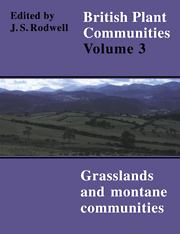Book contents
- Frontmatter
- Contents
- List of Figures
- Preface and Acknowledgements
- Preamble
- Mesotrophic Grasslands
- Community Descriptions
- Calcicolous Grasslands
- Community Descriptions
- Calcifugous Grasslands and Montane Communities
- Community Descriptions
- Index of Synonyms to Grasslands and Montane Communities
- Index of Species in Grasslands and Montane Communities
- Bibliography
MG10 - Holcus Lanatus-Juncus Effusus Rush-Pasture Holco-Juncetum Effusi Page 1980
Published online by Cambridge University Press: 04 July 2020
- Frontmatter
- Contents
- List of Figures
- Preface and Acknowledgements
- Preamble
- Mesotrophic Grasslands
- Community Descriptions
- Calcicolous Grasslands
- Community Descriptions
- Calcifugous Grasslands and Montane Communities
- Community Descriptions
- Index of Synonyms to Grasslands and Montane Communities
- Index of Species in Grasslands and Montane Communities
- Bibliography
Summary
Synonymy
Juncetum effusi Tansley 1939p.p.; Senecioni-Juncetum acutiflori ranunculetosum acris Br.-Bl. & R.Tx. 1951 p.p.;Lolio-Cynosuretum lotetosum uliginosi Sissingh & Tideman 1960 p.p.; Juncus effusus Group 1 vegetation Agnew 1961; Ranunculus repens-Juncus effusus community Birse & Robertson 1976 p.p.; Ordinary damp meadows Ratcliffe 1977.
Constant species
Agrostis stolonifera, Holcus lanatus, Juncus effusus, Ranunculus repens.
Physiognomy
The Holco-Juncetum effusi has a sward with prominent tussocks of Juncus effusus up to 80 cm tall in a generally species-poor and shorter grassy ground. Holcus lanatus and Agrostis stolonifera are the only constant grasses and each or both may be abundant. Poa trivialis, Lolium perenne, Alopecurus geniculatus, A. pratensis and Festuca pratensis are less frequent and usually much less abundant and other grasses occur but rarely. Sedges are generally uncommon throughout the community as a whole.
Dicotyledons are relatively few in number, although particular species may be conspicuous. Ranunculus repens and R. acris are frequent and sometimes abundant with generally smaller amounts of Cardamine pratensis, Trifolium repens, Rumex acetosa, Plantago lanceolata, Potentilla anserina and Cerastium fontanum. Taller Rumices, such as R. crispus, R. obtusifolius and R. conglomeratus are sometimes prominent. Poor-fen species such as Lotus uliginosus, Stellaria alsine and Cirsium palustre are never frequent.
Bryophytes are somewhat sparse, although Calliergon cuspidatum and Eurhynchium praelongum may attain abundance in some stands.
Sub-communities
Typical sub-community: Holco-Juncetum effusi typicum, variant solitus Page 1980. Here, J. effusus is always the most prominent rush but otherwise the floristics are those of the community as a whole.
Juncus inflexus sub-community: Holco-Juncetum effusi typicum, Juncus inflexus variant Page 1980. In this sub-community, J. inflexus partly or wholly replaces J. effusus, occurring as large isolated tussocks up to 1 m in diameter, with J. effusus generally as scattered shoots and small tussocks of low vitality. The vegetation is a little richer than in the Typical sub-community with Carex hirta, Trifolium repens and taller Rumices preferentially frequent.
Iris pseudacorus sub-community: Lolio-Cynosuretum juncetosum, Iris pseudacorus variant O’Sullivan 1968b) p.p.; Holco-Juncetum effusi iridetosum Page 1980. Here, I. pseudacorus is generally the most conspicuous species, attaining a height of up to 150 cm by midsummer and sometimes dominating in dense patches.
- Type
- Chapter
- Information
- British Plant Communities , pp. 88 - 93Publisher: Cambridge University PressPrint publication year: 1992

